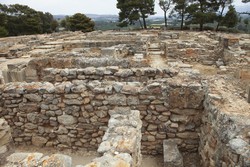Minoan Crete ties innovation with urbanisation
The Minoan civilisation in Bronze Age Crete (today Greece’s largest island) is widely considered Europe’s first advanced civilisation. It once boasted a sophisticated culture and urban environment in settlements like Knossos, Malia and Phaistos, where considerable innovation emerged. The EU-funded NETURBIN (A network approach to urbanization and processes of invention/innovation in the material culture of Bronze Age Crete (3100-1200 BCE)) project looked at the processes of invention and innovation on the island during Minoan times, i.e. from 3100-1200 BCE. It thoroughly investigated the correlation between urbanisation and processes of invention/innovation in Minoan material culture. To achieve its aims, the project team researched settlement growth, spatial organisation, site hierarchies and urban infrastructures. It graphically documented variables such as street layout, accessibility and density, comparing sites to one another and how they evolved. The group then studied the emergence of technological innovations in terms of ceramics, architecture, metalwork, glyptics, sculpting and writing, considering as well their spatial distribution. It highlighted the spread of these innovations in line with archaeological and other relevant data. This led to a better understanding of how urbanisation influenced the appearance and spread of technological inventions and innovations. The findings also helped shed light on the endurance of traditional expressions of material culture in Crete during the Bronze Age. Several key findings emerged from the project. For example, the most extensive spread of innovation happened in the Neopalatial period (1650-1400 BCE), fading away with the palatial collapse. Exceptions include weapons-making and sail-making, which continued to advance even towards the very end of the Bronze Age. In effect, the project helped document potential interconnections among the various settlements and examined how this led to spreading new techniques evidenced in archaeological records and in various crafts. The research effectively showed that the main palatial sites were indeed centres of diffusion of technological breakthroughs, while minor sites relayed innovations to more remote areas. This new light on Crete’s urbanisation and settlement patterns during the Bronze Age has come at a time when researchers are expressing new interest in the topic. The secrets of Europe’s earliest bastion of civilisation are slowly but surely being revealed.







